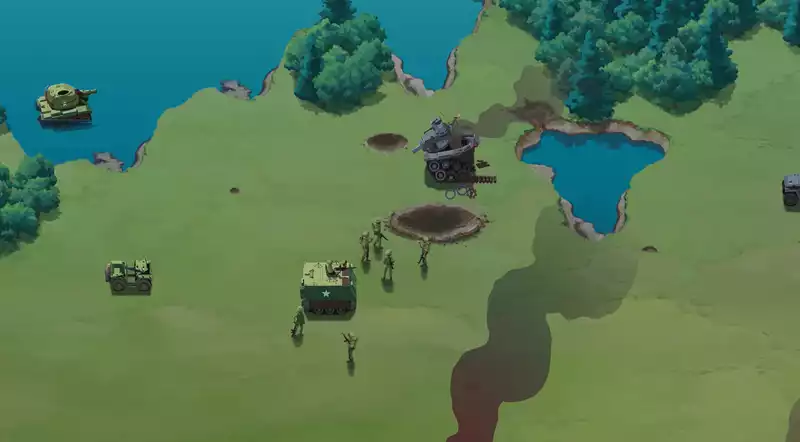Developer Zachtronics is known for its complex puzzle games, but Mobius Front '83 offers something completely different. It is a modern take on the niche genre of hardcore hex-based wargames. Even more intriguingly, "Mobius Front" pits the U.S. against its most despicable enemy to date. No, this is not a fifth column uprising, but a science fiction tale of the United States being invaded by an otherworldly version.
At the very least, this is the elevator pitch. Unfortunately, "Mobius Front" takes a while to get around to this novel premise, and several hours pass before we realize that this alternate world exists. Shabby story snippets are doled out in the form of interrogations of otherworldly prisoners, along with amusing banter between privates with delightful names like Private Nathan Trucks and Sergeant Benjamin Dancer. Subsequent chapters introduce more overt science fiction elements and things get more interesting, but the entire first chapter is several hours long, so it's not hard to imagine a number of players dropping out before things get really interesting.
Other activities in between missions include solitaire with airplane spotter cards, reading old Cold War-era military manuals (real pdfs read outside the game), and a signal-themed puzzle game that is a bit closer to Zachtronics' usual games. None of them were particularly deep distractions, and I only briefly ventured into each game before pushing forward, hoping to advance the story.
only lightly sprinkled salt on top of the tactical combat. Think of "Mobius Front" as an attempt to modernize a niche hex-based wargame like "Panzer Corps" and bring it closer to the mainstream. As such, there is no base building here; instead, units are selected from a pool and deployed in waves of reinforcements. In one mission, you might start with a small unit of infantry and have to hold out until a tank unit comes to your rescue. In another mission, a large force might be deployed on the front lines, but without reinforcements. This increases the variation needed in combat, especially since the maps on which the battles take place are almost always in the same forest. You may be fighting an enemy in a mirror world, but not with the same units. The choices are different, so, for example, alt-USA will play some missions with attack helicopters before you.
Let's talk about units: fans of WW2 wargames might think that tanks are mobile fortresses, but Mobius Front is set in the 80s, a time when armor is much more vulnerable due to the widespread use of anti-tank weapons. Even basic squads are equipped with rocket launchers that can destroy most vehicles with one lucky shot, and you quickly learn how quickly tanks sink when ambushed by troops hiding in the woods. By introducing a symmetrical conflict that didn't exist in the real 80s, Mobius Front gently guides the player through and makes you realize the power of inexpensive anti-tank weapons like the dreaded long-range TOW jeeps and Dragon anti-tank guided missiles. Eventually, attack helicopters appeared on the scene and quickly established themselves as the kings of the battlefield. They are fast, have long range, and can attack tanks and infantry alike, but are vulnerable to dedicated anti-aircraft units. Despite its streamlined approach, "The Mobius Front" is an excellent portrayal of the transition from mass warfare, as in World War II, to more modern warfare.
Tanks still have their uses, not for their toughness, but for their mobility. Tanks are extremely advantageous because they can both shoot and move. Units that cannot do this, which is most units, risk accidentally revealing themselves to the enemy and being shot to death before they get their turn. In contrast, infantry move slowly, have short range, and are surprisingly durable. They can only attack adjacent units, especially if they hide in the woods. Some of my greatest victories have come by deploying high-risk helicopters. They drop infantry units into enemy lines, forcing the enemy to spend several turns eliminating them while tank units desperately advance to relieve them. Mobility is really the key, as most missions involve capturing control points or destroying specific targets, but do not require simply destroying enemy forces.
What is striking is how accessible all of this is. There is no complicated action point system, every unit can either shoot or move, and the most complicated part is learning the handful of vehicles that can do both. Almost everything you need to know is made explicit when you click on a unit, including which weapons take a turn to set up (usually powerful long-range anti-tank weapons) and which vehicles can transport infantry squads (most vehicles do, but tanks cannot fire while soldiers are on them).
While Zachtronics succeeds in eliminating most of the potential low-levels, Mobius Front lacks many high levels as well. It is challenging enough, but there are no moments when you feel you have outwitted a cunning foe or pulled off a desperate upset. Most of the battles are largely predictable. The anecdotes of heroic unit victories and lucky blow reversals that make strategy games such a joy to play don't come to mind. The emphasis on winning the game, coupled with the generic and disposable nature of the units, makes the missions feel irreplaceable. Along with the slow pacing, the game can please, but never truly excite, and ultimately discourages the desire to keep going.
.

Comments